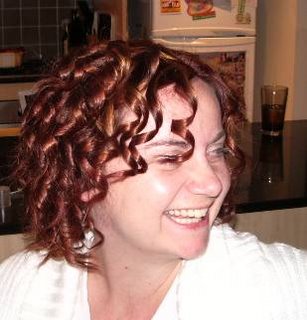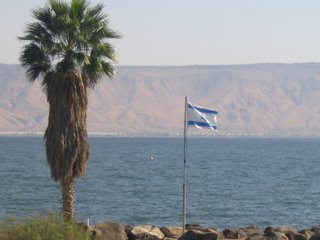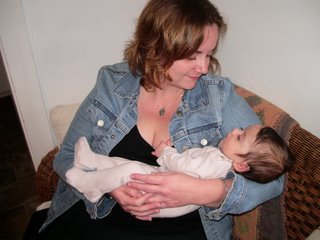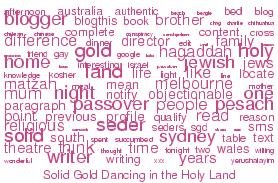Lest We Forget April 30, 2006 |

This last week Australian Jews commemorated both Anzac Day and Yom HaShoah (Holocaust Memorial Day). This coming week, we will commemorate and honour those who have lost their lives in war and terror attacks in Israel only to then discard our grief and transform it into joy as we celebrate the anniversary of the formation of the State of Israel.
Two years ago, I was blessed enough to be in Israel during this week and I wanted to share with you a little bit of my experience there.
Holocaust Memorial Day in Israel is an experience you cannot forget.
As we gathered in our student lounge and listened to music, songs, poems and family stories, we lit six Yarhzeit (Memorial) candles that burn for 24 hours in memory of the lives lost. We had the honour of meeting Solomon Malik, a survivor of the Holocaust, and we listened to his story.
Solomon was born in Hungary in the 1920’s. He and his twin sister tragically found themselves in the experimental laboratories of the infamous Dr Mengele in Auschwitz. By some miracle that can only be described as divine intervention, Solomon and his siblings survived. They survived starvation. They survived cruel and barbaric experimentation. They survived disease. One can only imagine the unthinkable horrors and images that those young children endured.
But Solomon survived. He and his sister both came to Israel and to illustrate the unbroken bond between them as twins, they both ended up having their children born on the same day. His sister died a few years ago of a disease no one could properly identify, and we can only guess that her disease later in life was in some way linked to the experiments the Nazi’s had cruelly conducted on her.
This morning, at 10am precisely, Israel stood still for two minutes. Sirens throughout the land rang out and the entire country literally stood still and in complete silence for two minutes. Try and conjure that image in your head. Imagine huge freeways coming to a total standstill. Drivers and passengers getting out of their vehicles and standing up on the road. Every place of work, every school in the country, even people in their homes.
As the siren faded, I could hear a lone bugle sounding in the distance. Everyone from the Merkaz Klita where I live came out and assembled on the courtyard, many of us wearing white, to signify mourning. Each one of us stood still and listened as the air was filled with the haunting echo of the siren. I looked around me. We were American, English, Australian, Belgian, French, Canadian, Russian, Ethiopian and we were all Jews.
We were all Jews in Israel and we were all united in our remembrance of the blackest moment in the history of our people.
I thought about all the people from my mother’s family that lost their lives in the Holocaust. I thank G-d that my grandparents escaped Poland just before the outbreak of the war – because had they not, I would not be standing here in Israel today, honouring the lives of all those people who were slaughtered like animals.
I thank G-d for many things. But today, I thank G-d for Israel.
Less than a week after observing Yom HaShoah, we were once again, as a nation, united in grief and mourning for the loss of countless lives – of Israel’s fallen soldiers, and now, tragically, the victims of terror.
On the eve of Yom HaZikaron, we gathered in the town centre for the official ceremony. There, against a backdrop of torches, each signifying the loss of some of Arad’s local residents, we listened to songs, testimony, and the Kaddish – the Jewish prayer for the dead. Once again, a two-minute long siren brought with it, silence.
I awoke the next morning and headed downstairs to hear testimony from my friend and former madricha (leader), Galit. Galit performed her army service during the war with Lebanon. Although she personally was not stationed there, many of her friends were.
Among them was her childhood friend Itamar, a boy she had known while growing up in Arad. Itamar had been accepted to an elite combat unit in the army. He was on a secret mission in Lebanon that failed – tragically. Itamar and several other members of his unit were ambushed and blown up. Itamar’s body was the one body the army were unable to piece together. He was 21 years old.
An hour or so later I was standing in front of Itamar’s grave at the Arad Cemetery. I stared at the standard army issue grave, covered in flowers, yahrzeit candles and most oddly, cacti. There were several ceramic pots filled with exotic desert cactus plants, blooming with wild flowers. I thought how amazing it was that such a harsh plant as the cactus could be sitting on a gravestone. And then I really thought about it. The flowers were beautiful. In the desert, a cactus survives, thrives even. It can survive months without water. The cactus was a symbol. Even in the harshest conditions; conditions that would normally kill most living things, beauty and life can survive and even flourish. The memory of young Itamar burns brightly, long after the yahrzeit candle has burned to nothing.
As the sun set on Yom HaZikaron and our thoughts turned to the imminent Yom Ha’atzmaut celebrations, I struggled to understand how Israelis could do it every year – especially when every year there are more tragedies and more parents have had to bury their children. Even more remarkable, how they could turn their grief into joy in a matter of hours? How can a country go from having being plunged to the greatest depth of mourning to overwhelming joy and celebration for Yom Ha’atzmaut (Israeli Independence Day)? Only the night before, another young soldier had been killed in Hebron – and so his family were burying him on Yom Ha’atzmaut. What did this family have to celebrate? What would they ever have to celebrate?
Before going downstairs to attend our Independence Day celebrations, I washed my face, peeled the “Yizkor” (Remembrance) sticker off my white shirt and got changed. Together, we walked into town. Young and old alike were waving the Israeli flag. At 10pm the sky lit up with a beautiful fireworks display.
I looked around me at all the people and felt an undeniable sense of pride and patriotism. This was my first Yom Ha’atzmaut in Israel and as an Israeli. I began to understand how Israel is able to make this fundamental psychological shift in the space of a day. We are an amazingly resilient people, and Israel is an amazingly resilient country. We are a people that have suffered unthinkable tragedy throughout time.
People often refer to native-born Israelis as “Sabras.” The Sabra is a desert cactus – prickly on the outside and sweet on the inside. Israel is a cactus too. It needs to have a strong defensive exterior to protect itself. It needs to protect itself so that the inside – its people – can survive. And they do. Yom Ha’atzmaut is more than a celebration of independence. It is a celebration of survival. And that is every reason to celebrate.






